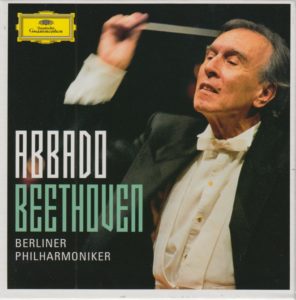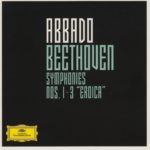 This morning, I return to the top of the batting order with Italian conductor Claudio Abbado (1933-2014).
This morning, I return to the top of the batting order with Italian conductor Claudio Abbado (1933-2014).
The orchestra is the Berliner Philharmoniker.
The record label is the legendary 120-year-old Deutsche Grammophon.
The only difference this time is I’m listening to Beethoven’s Symphony No. 3 in E flat Major, Opus 55 – also known as Eroica (“Heroic”).
Of Beethoven’s Third, its entry on Wikipedia tells us,
The Symphony No. 3 in E♭ major, Op. 55, (also Italian Sinfonia Eroica, Heroic Symphony) is a symphony in four movements by Ludwig van Beethoven. One of the composer’s most celebrated works, the Eroica symphony is a large-scale composition that marked the beginning of Beethoven’s creative middle-period.
Depending upon the conductor’s style and observation of the exposition repeat in the first movement, the performance time is between 41 and 56 minutes.
Composed mainly in 1803–1804, the work is grounded in the Classical symphonic tradition while also stretching boundaries of form, length, harmony, and perceived emotional and possibly cultural content. It has therefore widely been considered an important landmark in the transition between the Classical period and the Romantic era.
Beethoven began composing the third symphony soon after Symphony No. 2 in D major, Opus 36 and completed the composition in early 1804. The first public performance of Symphony No. 3 was on 7 April 1805 in Vienna.
There is significant evidence that the Eroica, perhaps unlike Beethoven’s other symphonies, was constructed back-to-front. The theme used in the fourth movement, including its bass line, originate from the seventh of Beethoven’s 12 Contredanses for Orchestra, WoO 14 and also from the Finale to his ballet The Creatures of Prometheus, Op. 43, both of which were composed in the winter of 1800–1801. The next year, Beethoven used the same theme as the basis for his Variations and Fugue for Piano in E♭ Major, Op. 35, now commonly known as the Eroica Variations due to the theme’s re-use in the symphony. It is the only theme that Beethoven used for so many separate works in his lifetime, and each use is in the same key of E♭ major.
Okay. I get it. It’s An. Important. Symphony.
But is it one to which I enjoy listening?
Ahh, there’s the rub.
We’ll see.
First, the facts.
I first heard Maestro Abaddo on Day 1 and then again on Day 19.
 Beethoven wrote his symphonies in four parts (except for the Sixth, which is in five). The time breakdown of this particular one (Symphony No. 3 in E flat Major), from this particular conductor (Abbado, at age 68) and this particular orchestra (Berliner Philharmoniker), at this particular time in history (February, 2001) on this particular record label (Deutsche Grammophon) is as follows:
Beethoven wrote his symphonies in four parts (except for the Sixth, which is in five). The time breakdown of this particular one (Symphony No. 3 in E flat Major), from this particular conductor (Abbado, at age 68) and this particular orchestra (Berliner Philharmoniker), at this particular time in history (February, 2001) on this particular record label (Deutsche Grammophon) is as follows:
Allegro con brio………………………………………………………………………16:56
Marcia funebre: Adagio assai…………………………………………………14:49
Scherzo: Allegro vivace – Trio……………………………………………………5:52
Finale: Allegro molto – Poco andante – Presto………………………11:06
Total running time: 48:03
My Rating:
Recording quality: 4 (still seems to lack the high end, although there’s very little tape hiss)
Overall musicianship: 4 (supremely competent; yet, not inspired)
CD liner notes: 4 (liner notes consist of all necessary technical detail, plus an essay about Abbado’s approach to conducting Beethoven, translated into E/G/F/I)
How does this make me feel: 3 (another definite “Meh”)
I have a soft spot in my heart for Pizzicato, the technique of plucking strings. It makes a lighthearted, playful sound. Whenever I hear it, I think of cartoon characters sneaking up on one another on tip toe.
A short passage in Movement I featured pizzicato, and the beginning of Movement IV featured pizzicato. I enjoyed both immensely.
I found it interesting that Symphony No. 3 starts with two short bursts the same way Symphony No. 2 does. The emphasis is different, though:
Dat!…Dat!…
Then a quiet interlude as the first movement unfolds.
Symphony No. 2 begins with the two notes together in Morse Code fashion:
Da-Dahhh!
Then a quiet interlude as the first movement unfolds.
Regarding those first movements, I find Beethoven’s Second Symphony to be rousing and fun and memorable. Movement I rocks in the Second.
In the Third, I listened intently all the way through twice. And I don’t remember a single aspect of it other than the opening two notes. At this rate, listening to 18 days of this is likely to be a tough row to hoe.
Maybe it’s not fair to Claudio Abbado to occupy the first spot in my roster of conductors. It usually takes me awhile to get used to a new symphony. So unless it grabs me hard and fast, I’m likely to rate it with a “Meh,” which is what I’m doing this time as well.
I realize Eroica is an important work. I realize it’s a transitional symphony for Beethoven. I realize I’m suppose to revere the hell out of it.
But I’m just not feeling it.
I can’t tell if it’s a less-than-robust performance, a less-than-dynamic recording, or just a symphony that doesn’t grab me.
No matter how you slice it, I can’t rate today’s performance above a “Meh.”
Here’s a sample of Claudio Abbado conducting the Berliner Philharmoniker in Rome, on 9 February 2001:
